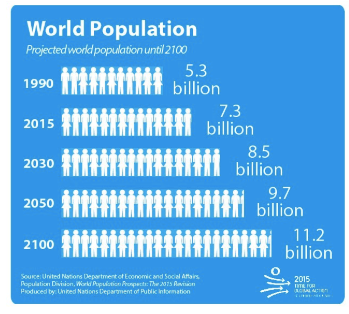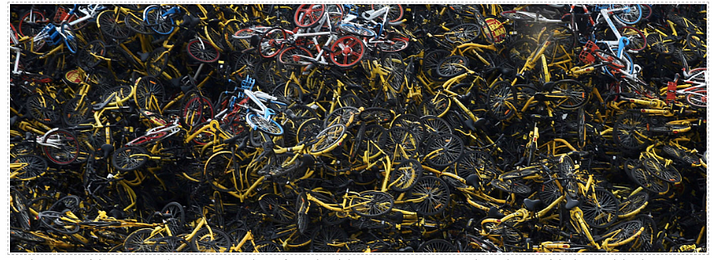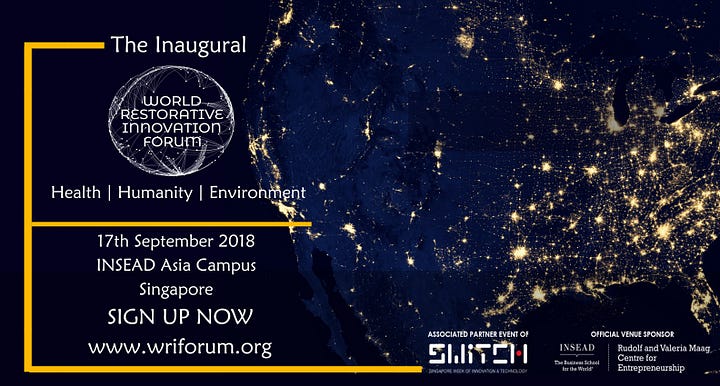There is hazard from our relentless pursuit of economic growth from innovation; I want to advance a new narrative — one which hopes to restore health, humanity and the environment

“How did you go bankrupt?” Bill asked.
“Two ways,” Mike said. “Gradually and then suddenly.”
“What brought it on?”
“Friends,” said Mike. “I had lots of friends.”
– Ernest Hemingway in The Sun Also Rises (1926)
I start this post with a question about how we can feed 9 billion people by 2050, knowing that our agriculture production methods deplete our planet’s resources at an alarming rate and that 14–15% of climate change can be attributed to inefficiencies in agriculture methods, For example, we know that it takes 25 calories to produce 1 calorie of beef protein— this is not a sustainable model of consumption. We know that cattle raising occupies 30% of the world’s surface and accounts for 18% of human-caused greenhouse gases.
Our meat consumption is expected to grow from 612,000 tons of meat production (2016 figure) with an increase of 11.7% by 2025 (USDA estimates), exerting further pressure on resources — raising livestock accounts for roughly 23 percent of all global water use in agriculture, or equivalent to 1.15 litres of water per person per day.
If we continue this path of consumption, will our earth continue to feed us, quench our thirst, cloth us — power our homes, factories, vehicles, and devices?

Our population growth, economic growth, and the resulting climate change are creating unprecedented resource stress on our planet. For example, it is estimated that by 2030, we will see a water demand to supply gap of 40%. If we continue to consume the resources of this earth without regards to its regenerative timescale, perhaps one day, the earth would go bankrupt because she befriended too many humans.
What happened to the St. Matthews Island Reindeers is instructive on the devastating effects to an ecosystem when it exceeds the carrying capacity. In August 1944, the US Coast guard installed a LORAN (Long range Radio Navigation) operation along with 19 men and 29 reindeers (as fresh meat) in St. Matthews Island, an isolated island north of the Aleutian Islands in Alaska, to act as a defense against Japanese invaders.
After the Japanese surrender, the LORAN post was closed, and the reindeers were left behind. Over the next 2 decades, a biologist, David Klein, visited St. Matthews to study and inventory the reindeers. The first visit in 1957 showed a healthy population of 1,350 reindeers, a 47x growth, due to good habitat and the lack of predators. When he visited again in 1963, there were over 6,000 reindeers, but many of them showed signs of malnutrition. 3 years later, suddenly, the population drop precipitously to only 42, and they were all females with 1 deformed male. Inevitably, they went extinct from that island.
I use the lens of innovation frameworks to build a narrative around how do we use science and innovation to restore nature, and by extension, humanity. The St. Matthews reindeers story is to gain your attention. Let us use our collective reflections to understand the philosophy of science, and later, bring the narrative to Innovation, and then to Restorative Innovation.
We start this discussion on the philosophy of Science by citing Thomas Kuhn, in The Structure of Scientific Revolution, who sees scientific practice as a set of social norms and common beliefs — or what we term as a paradigm. Science, then, is about progressing from one paradigm to the next — when enough of a paradigm explains the perceived reality, we then adopt it and fit all prior knowledge into this paradigm. An accepted paradigm then leads into a particular pathway of technological development and innovative practices along that paradigm’s trajectory.
In our collective worldview from the post-industrial revolution, we live in a Newtonian paradigm of a mechanical, reductionist world, where everything can be componentised into parts, and optimized and mass-produced — a philosophy of science that is fundamentally about a linear system, as influenced by Galileo Galilei and Rene Descartes.
For phenomena which we do not understand, we park them under Chaos theory or Complexity theory, because the objective of our current science paradigm is to formulate models to explain and predict outcomes. This paradigm has served us well — humanity has made tremendous progress in scientific discoveries, efficiencies in production systems, manufacturing and scaling production which enables low-cost and wider consumption, and now we are on the verge of automating a wide range of processes with use of AI, Robotics, etc.
Also read: How these 6 Asian startups are using tech to solve environmental issues
The scientific and technological progress has enabled economic growth, and enabled the majority of humanity to enjoy higher standards of living and greater consumptive powers in each successive generation. We extract all of our resources from this earth, and all we pay is extraction cost, which doesn’t even come close to represent a minuscule, fractional cost of the replacement of the resource. If we are to pay the real economic cost of the use of resources, would we still consume at such a frantic pace?

Graphics Source: http://www.sahtouris.com
Interestingly, the ancient Greek philosophers had a more holistic view of science. Science, to the ancient Greeks, is rooted in nature, and in learning from nature. Plato and Aristotle both see an interdependent relationship between ‘physis’, where nature is the source of growth or change, and ‘poiesis’, or the formation or new creation. In particular, Aristotle believed that to understand the world, we need to understand how change continually transform matter into new forms. In our modern day reductionist paradigm, we have lost touch with what nature is telling us.
We live in a world marked by innovations, or the modern version of poiesis, which we pursue both in startups and established enterprises because innovations bring growth. But the motivation behind this pursuit of growth is measured in economic output, where indicators of progress are almost always expressed in performance terms that can be optimised.
For example, in individual businesses, typical indicators are sales/profit and market capitalisation growth. Collectively for an economy or a nation state such as Singapore, the indicator of this successful pursuit is measured as increasing GDP — or the sum total of all monetary transactions per capita in the economy.
Please allow me to ask you, “is GDP really a true indicator of growth?”
If we spend money on healthcare because our citizens suffer the 2nd highest per capita rate of diabetes amongst developed countries, second only to the U.S., or if we spend money to clean up oil spills from our ocean, or for us to lock up criminals or to implement counter-terrorism measures as a result of our breakdown in humanity, is this growth?
Our relentless pursuit of economic growth in our innovation model has startups locked in the race to become the dominant platform by bringing faster, cheaper products and services to customers
Here I cite the example of China’s bike-sharing companies, because you will see paradigms magnified and amplified due to the sheer size and speed of the Chinese market. While Ofo and Mobike are the darlings of venture capitalists who have funded them to the tune of US$ 2.2 Billion, I see massive number of bicycles being strewn haphazardly and resources being extracted and wasted in their competing efforts to gain market dominance.
Also read: The alarming environmental impact of Bitcoin mining
This is the hazard from our relentless pursuit of economic growth from innovation. The ancient Greek philosophers would not foresee that our pursuit of ‘poiesis’ is creating negative impact to ‘physis’, as they saw ‘poiesis’ as a bringing forth of that which is beautiful.

For the source of this image, and more amazing photos from China’s hypercompetitive race to be at the top of the heap in bike sharing, please refer to this article on TheAtlantic.
I want to advance a new narrative to innovation, one which hopes to restore health, humanity and the environment. I am still in the early stages of evangelizing this framework, but fortunately, I am privileged to be able to influence many young entrepreneurs and startups in Singapore, having been teaching the subject of technology entrepreneurship at multiple universities for the past decade. I am calling this new framework Restorative Innovation, and I offer an economic model for innovators to consider as they ideate around value creation in new venturing.

Tune in next week as I break this model down. In the meantime, please follow us in the below channels and we would like to invite you to attend the join the first World Restorative Innovation Forum(WRIF) in Singapore to understand and apply Restorative Innovation in your ventures and strategy! Restorative Innovation aims to innovate while restoring Health, Humanity and Environment. Meet and hear from the brightest and best minds of academia and business.
—-
Follow us: Facebook, LinkedIn, Website, Event Page
e27 publishes relevant guest contributions from the community. Share your honest opinions and expert knowledge by submitting your content here.
The post Restorative Innovation movement offers a new narrative, with focus on health, humanity, and environment appeared first on e27.